Spring phenology drives range shifts in a migratory Arctic ungulate with key implications for the future
- PMID: 33993595
- PMCID: PMC8456794
- DOI: 10.1111/gcb.15682
Spring phenology drives range shifts in a migratory Arctic ungulate with key implications for the future
Abstract
Annual variation in phenology can have profound effects on the behavior of animals. As climate change advances spring phenology in ecosystems around the globe, it is becoming increasingly important to understand how animals respond to variation in the timing of seasonal events and how their responses may shift in the future. We investigated the influence of spring phenology on the behavior of migratory, barren-ground caribou (Rangifer tarandus), a species that has evolved to cope with short Arctic summers. Specifically, we examined the effect of spring snow melt and vegetation growth on the current and potential future space-use patterns of the Porcupine Caribou Herd (PCH), which exhibits large, inter-annual shifts in their calving and post-calving distributions across the U.S.-Canadian border. We quantified PCH selection for snow melt and vegetation phenology using machine learning models, determined how selection resulted in annual shifts in space-use, and then projected future distributions based on climate-driven phenology models. Caribou exhibited strong, scale-dependent selection for both snow melt and vegetation growth. During the calving season, caribou selected areas at finer scales where the snow had melted and vegetation was greening, but within broader landscapes that were still brown or snow covered. During the post-calving season, they selected vegetation with intermediate biomass expected to have high forage quality. Annual variation in spring phenology predicted major shifts in PCH space-use. In years with early spring phenology, PCH predominately used habitat in Alaska, while in years with late phenology, they spent more time in Yukon. Future climate conditions were projected to advance spring phenology, shifting PCH calving and post-calving distributions further west into Alaska. Our results demonstrate that caribou selection for habitat in specific phenological stages drive dramatic shifts in annual space-use patterns, and will likely affect future distributions, underscoring the importance of maintaining sufficient suitable habitat to allow for behavioral plasticity.
Keywords: Rangifer tarandus; Arctic; Porcupine Caribou Herd; caribou; climate change; large herbivore; migration; phenology; range shift; resource selection.
© 2021 The Authors. Global Change Biology published by John Wiley & Sons Ltd. This article has been contributed to by US Government employees and their work is in the public domain in the USA.
Figures


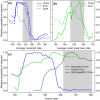
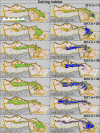
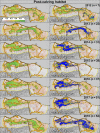


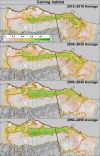
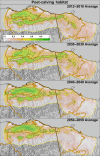
References
-
- Aikens, E. O., Mysterud, A., Merkle, J. A., Cagnacci, F., Rivrud, I. M., Hebblewhite, M., Hurley, M. A., Peters, W., Bergen, S., De Groeve, J., Dwinnell, S. P. H., Gehr, B., Heurich, M., Hewison, A. J. M., Jarnemo, A., Kjellander, P., Kröschel, M., Licoppe, A., Linnell, J. D. C., … Kauffman, M. J. (2020). Wave‐like patterns of plant phenology determine ungulate movement tactics. Current Biology, 30(17), 3444–3449.e4. 10.1016/j.cub.2020.06.032 - DOI - PubMed
-
- Baddeley, A., Rubak, E., & Turner, R. (2016). Spatial point patterns: Methodology and applications with R. Chapman & Hall/CRC Interdisciplinary Statistics Series. CRC Press, Taylor & Francis Group.
-
- Barboza, P. S., Van Someren, L. L., Gustine, D. D., & Bret‐Harte, M. S. (2018). The nitrogen window for arctic herbivores: Plant phenology and protein gain of migratory caribou (Rangifer tarandus). Ecosphere, 9, e02073. 10.1002/ecs2.2073 - DOI
MeSH terms
LinkOut - more resources
Full Text Sources
Other Literature Sources
Research Materials

